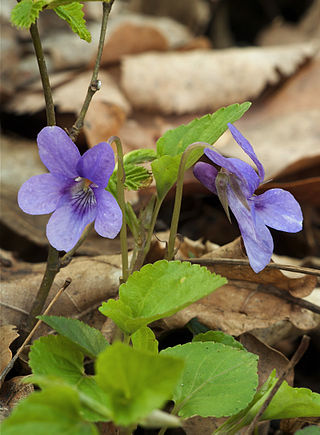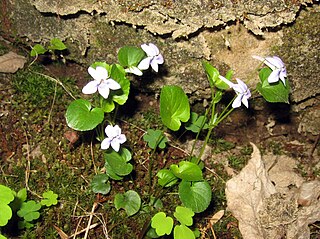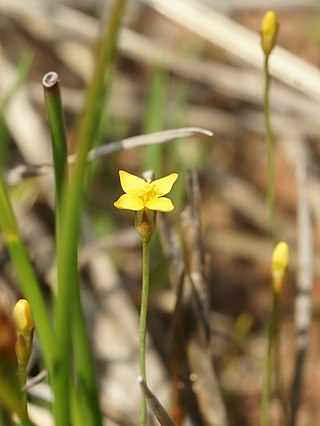
Viola is a genus of flowering plants in the violet family Violaceae. It is the largest genus in the family, containing between 525 and 600 species. Most species are found in the temperate Northern Hemisphere; however, some are also found in widely divergent areas such as Hawaii, Australasia, and the Andes.

Viola canina is a species of the genus Viola, native to Europe, where it is found in heaths, fens, and moist woodlands, especially on acidic soils.

Viola riviniana, the common dog-violet, is a species of flowering plant in the family Violaceae, native to Eurasia and Africa. It is also called wood violet and dog violet. It inhabits woodland edges, grassland and shady hedge banks. It is found in all soils except those which are acid or very wet.

A wildflower is a flower that grows in the wild, meaning it was not intentionally seeded or planted. The term implies that the plant probably is neither a hybrid nor a selected cultivar that is in any way different from the way it appears in the wild as a native plant, even if it is growing where it would not naturally. The term can refer to the flowering plant as a whole, even when not in bloom, and not just the flower.

The Botanical Society of Britain and Ireland (BSBI) is a scientific society for the study of flora, plant distribution and taxonomy relating to Great Britain, Ireland, the Channel Islands and the Isle of Man. The society was founded as the Botanical Society of London in 1836, and became the Botanical Society of the British Isles, eventually changing to its current name in 2013. It includes both professional and amateur members and is the largest organisation devoted to botany in the British Isles. Its history is recounted in David Allen's book The Botanists.

Clive Anthony Stace is a British botanist and botanical author. He studied at King's College London, graduated from University of London in 1959 and then studied at the Natural History Museum, London. He was awarded a PhD in 1963. His academic career was based at the University of Leicester, where he held the post of Professor of Plant taxonomy. He is a past president of the Botanical Society of Britain and Ireland from 1987 to 1989.

Potamogeton praelongus, commonly known as whitestem pondweed in North America and long-stalked pondweed in Britain, is a large, perennial aquatic plant in the family Potamogetonaceae. It is widely distributed in lakes and rivers in the northern hemisphere, but is sensitive to poor water quality.

Viola reichenbachiana, also known as the early dog-violet, pale wood violet, slender wood violet, hedge violet, or wood dog violet, is a species of flowering plant in the Viola genus. This species hybridises with Viola riviniana, the common dog-violet, to produce Viola × bavarica.. The plant is named after the 19th century botanist Ludwig Reichenbach. It is a rhizomatous herbaceous perennial that is widely known for its purple petals, and it typically resides along road banks or among other rich vegetation, as other wild pansies do. The name dog violet refers to its lack of scent, making it supposedly only fit for dogs.

Viola rostrata, commonly called the long-spurred violet, is an herbaceous plant in the violet family (Violaceae). It is native to eastern North America, where it is found in Canada and the United States, primarily in the Northeastern, Midwestern, and Appalachian regions. Its natural habitat is acidic mesic forests, often growing near Tsuga canadensis.

Potamogeton coloratus, the fen pondweed, is an aquatic plant in the genus Potamogeton. It is found in shallow peaty calcareous lakes, ponds and ditches, commonly associated with lowland fens.

Potamogeton alpinus is a species of perennial aquatic plant known by the common names alpine pondweed and red pondweed. It is widespread in the northern hemisphere in both rivers and lakes with good water quality.

Potamogeton epihydrus is a perennial aquatic plant known by the common names ribbonleaf pondweed and Nuttall's pondweed, and American pondweed in the United Kingdom. It is native to much of North America, where it grows in water bodies such as ponds, lakes, ditches, and slow-moving streams.

Potamogeton gramineus is a species of aquatic plant known by the common name various-leaved pondweed, variableleaf pondweed, grass-leaved pondweed or grassy pondweed, native to the northern hemisphere where it grows in shallow, clean water.

Potamogeton compressus is a species of aquatic plant known by the common names grass-wrack pondweed, flatstem pondweed and eel-grass pondweed.

Potamogeton obtusifolius, known as blunt-leaved pondweed, is an aquatic plant in the genus Potamogeton. It grows mainly in mesotrophic to eutrophic lakes, ponds and ditches, rarely in brackish water. It occurs primarily in Central Europe, the British Isles, Fennoscandia and eastern North America.

Potamogeton acutifolius is a European species of aquatic plant in the family Potamogetonaceae, known by the common name sharp-leaved pondweed. It is threatened and declining in at least part of its range.

Iris lactea is a species in the genus Iris, it is also in the subgenus Limniris. and the series Ensatae, it is the only species in the series. The Japanese water iris, Iris ensata, is actually in series Laevigatae. It is a rhizomatous perennial, from central Asia, with pale blue or violet flowers. It is cultivated as an ornamental plant in temperate regions.
Potamogeton × griffithii is a hybrid pondweed between Potamogeton alpinus and Potamogeton praelongus. It occurs in oligotrophic, moderate alkalinity lakes.

Potamogeton friesii, known as flat-stalked pondweed, or Fries' pondweed, is an aquatic plant in the genus Potamogeton. It grows mainly in mesotrophic to eutrophic rivers, lakes, ponds and ditches, rarely in brackish water. It occurs in North America, Europe, western Asia and a few scattered locations elsewhere in Asia.

Cicendia filiformis, also called yellow centaury or slender cicendia, is a species of flowering planet of the family Gentianaceae.



















